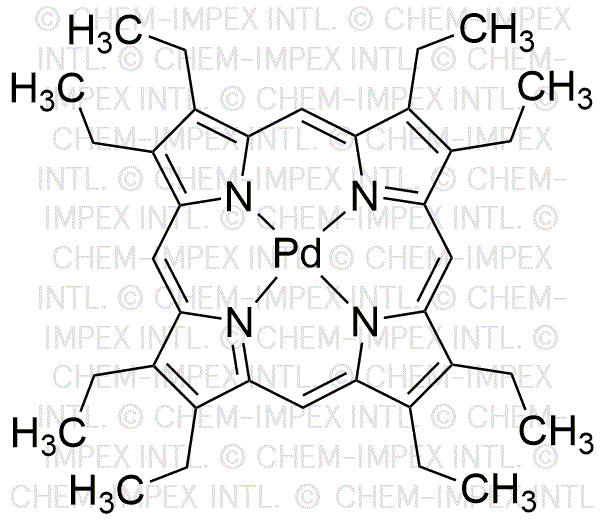Palladium(II) 2,3,7,8,12,13,17,18-(octaethyl)porphyrin is widely utilized in research focused on:
- Catalysis: This compound serves as an effective catalyst in various organic reactions, particularly in cross-coupling reactions, which are essential in the synthesis of pharmaceuticals and agrochemicals.
- Photodynamic Therapy: It is used in medical applications, especially in photodynamic therapy for cancer treatment, where its light-absorbing properties help generate reactive oxygen species to target and destroy cancer cells.
- Sensors: The compound is incorporated into sensor technologies for detecting gases and biomolecules, providing high sensitivity and selectivity, which is crucial in environmental monitoring and medical diagnostics.
- Material Science: In the field of material science, it is utilized in the development of advanced materials, including organic photovoltaics and light-emitting devices, enhancing efficiency and performance.
- Research in Coordination Chemistry: It serves as a model compound in coordination chemistry studies, helping researchers understand metal-ligand interactions and the behavior of transition metal complexes.
General Information
Properties
Safety and Regulations
Applications
Palladium(II) 2,3,7,8,12,13,17,18-(octaethyl)porphyrin is widely utilized in research focused on:
- Catalysis: This compound serves as an effective catalyst in various organic reactions, particularly in cross-coupling reactions, which are essential in the synthesis of pharmaceuticals and agrochemicals.
- Photodynamic Therapy: It is used in medical applications, especially in photodynamic therapy for cancer treatment, where its light-absorbing properties help generate reactive oxygen species to target and destroy cancer cells.
- Sensors: The compound is incorporated into sensor technologies for detecting gases and biomolecules, providing high sensitivity and selectivity, which is crucial in environmental monitoring and medical diagnostics.
- Material Science: In the field of material science, it is utilized in the development of advanced materials, including organic photovoltaics and light-emitting devices, enhancing efficiency and performance.
- Research in Coordination Chemistry: It serves as a model compound in coordination chemistry studies, helping researchers understand metal-ligand interactions and the behavior of transition metal complexes.
Documents
Safety Data Sheets (SDS)
The SDS provides comprehensive safety information on handling, storage, and disposal of the product.
Product Specification (PS)
The PS provides a comprehensive breakdown of the product’s properties, including chemical composition, physical state, purity, and storage requirements. It also details acceptable quality ranges and the product's intended applications.
Certificates of Analysis (COA)
Search for Certificates of Analysis (COA) by entering the products Lot Number. Lot and Batch Numbers can be found on a product’s label following the words ‘Lot’ or ‘Batch’.
*Catalog Number
*Lot Number
Certificates Of Origin (COO)
This COO confirms the country where the product was manufactured, and also details the materials and components used in it and whether it is derived from natural, synthetic, or other specific sources. This certificate may be required for customs, trade, and regulatory compliance.
*Catalog Number
*Lot Number
Safety Data Sheets (SDS)
The SDS provides comprehensive safety information on handling, storage, and disposal of the product.
DownloadProduct Specification (PS)
The PS provides a comprehensive breakdown of the product’s properties, including chemical composition, physical state, purity, and storage requirements. It also details acceptable quality ranges and the product's intended applications.
DownloadCertificates of Analysis (COA)
Search for Certificates of Analysis (COA) by entering the products Lot Number. Lot and Batch Numbers can be found on a product’s label following the words ‘Lot’ or ‘Batch’.
*Catalog Number
*Lot Number
Certificates Of Origin (COO)
This COO confirms the country where the product was manufactured, and also details the materials and components used in it and whether it is derived from natural, synthetic, or other specific sources. This certificate may be required for customs, trade, and regulatory compliance.


